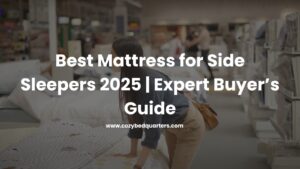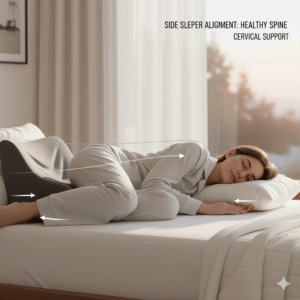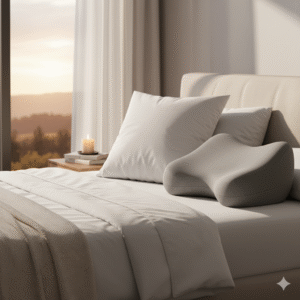<!doctype html>
Optimal Sleep Temperature: Achieve Quality Rest Every Night
Quick answer: The optimal sleep temperature is typically a bedroom set to 60–70°F (15.5–21°C) with an average sweet spot near 65°F (18.3°C), and a cozy under-the-covers microclimate of 80.6–89.6°F (27–31°C). Keep bedding breathable, manage humidity, and ventilate the room for deeper, more consistent sleep.
Key Takeaways on Optimal Sleep Temperature
- Set your bedroom to 60–70°F (15.5–21°C); many sleepers thrive around 65°F (18.3°C).
- Under the covers, aim for a warm microclimate of 27–31°C (80.6–89.6°F) for comfort without overheating.
- Heat increases wakefulness and reduces REM/slow-wave sleep; cold affects cardiovascular responses—both can disturb rest.
- Use breathable, moisture‑wicking bedding and light sleepwear to maintain an optimal sleep temperature.
- Control humidity and airflow (fans/AC or ventilation) to stabilize temperature across the night.
- If you struggle with insomnia, a cooler, consistent room temp can support your natural nighttime temperature drop.
Are you struggling to get a good night’s sleep? The culprit might be the temperature. It turns out that the thermal environment plays a crucial role in determining the quality of our sleep. Whether it’s too hot or too cold, the temperature can significantly impact our sleep stages and overall sleep quality.
Bottom line up front: When we’re exposed to heat during sleep, it increases wakefulness and decreases the important stages of sleep like rapid eye movement (REM) sleep and slow wave sleep. Cold exposure doesn’t necessarily disrupt stages but can change how the heart responds during sleep. That’s why it’s essential to maintain an optimal sleep temperature for better rest and overall sleep quality.
Key Concepts
- Temperature plays a crucial role in determining the quality of our sleep.
- Heat exposure leads to increased wakefulness and decreased REM sleep and slow wave sleep.
- Cold exposure influences the cardiac autonomic response during sleep.
- Maintaining an optimal sleep temperature is important for better rest and sleep quality.
- Creating the ideal sleep environment involves finding the right temperature, bedding, and humidity levels.
How Temperature Affects Sleep and Thermoregulation
In one sentence: Your body naturally cools at night, and aligning your room and bedding to support that drop helps you fall asleep faster and reach deeper stages.
Temperature plays a significant role in the quality of your sleep and the regulation of your body’s internal temperature. Your sleep is closely linked to thermoregulation, which is controlled by your circadian rhythm and sleep regulation. Throughout the night, your core body temperature (Tcore) naturally decreases during sleep and increases when you wake up, following a 24-hour circadian rhythm.
One key factor in thermoregulation is the adjustment of blood flow to your skin, which is controlled by your distal skin temperature (Tsk). When your Tsk increases, it promotes the rapid onset of sleep. Interestingly, different sleep stages are sensitive to temperature changes to varying degrees. REM sleep, for example, is less affected by hot or cold stimulation compared to non-REM sleep and wakefulness.
In addition to your body’s natural thermoregulation, your behavior and sleep environment also play a role in maintaining an optimal sleep temperature. Factors like bed cover behaviors and sleep positions can impact your sleep quality. By understanding how temperature affects sleep and thermoregulation, you can make adjustments to create a comfortable and supportive sleep environment.
Creating the Optimal Sleep Environment
Do this first: Keep your bedroom between 60–70°F (15.5–21°C)—many sleepers prefer about 65°F (18.3°C)—and target an under-the-covers temperature of 27–31°C (80.6–89.6°F).
When it comes to maintaining a proper sleep temperature, the ideal bedroom temperature is typically between 15.5-21°C (60-70°F), with an average of 18.3°C. To ensure good sleep, the temperature under your covers should be around 27-31°C (80.6-89.6°F). However, it’s essential to find the temperature that works best for you based on your individual preferences.
Along with temperature, considerations like bedding and humidity should also be taken into account when creating the optimal sleep environment. By making adjustments to create the best sleep conditions for yourself, you can enhance your rest and overall well-being.

| Effects of Temperature on Sleep | Regulating Sleep Temperature |
|---|---|
| – Temperature impacts sleep stages | – Adjust bedding and clothing for thermoregulation |
| – Heat exposure increases wakefulness | – Keep bedroom temperature between 15.5-21°C (60-70°F) |
| – Cold exposure influences cardiac autonomic response | – Under covers temperature should be 27-31°C (80.6-89.6°F) |
| – Distal skin temperature promotes rapid sleep onset | – Consider bedding and humidity in sleep environment |
Understanding the relationship between temperature and sleep is crucial for maintaining proper sleep quality. By regulating your sleep temperature and creating a comfortable sleep environment, you can optimize your rest and improve your overall well-being.
The Effects of Heat Exposure on Sleep Quality
Takeaway: Sleeping too warm makes you wake more and cuts down deep and REM sleep—cool the room, cool the bedding.
When it comes to getting a good night’s sleep, the temperature of your sleep environment plays a crucial role. Heat exposure during sleep can have significant effects on your sleep quality, leading to increased wakefulness and decreased slow wave sleep and REM sleep. High humidity during heat exposure can further disrupt your sleep stages and thermoregulation.
It is important to note that heat has a greater impact on sleep stages compared to cold exposure in real-life situations. The increase in wakefulness caused by heat exposure can have adverse effects on your health, such as obesity and decreased quality of life. Therefore, maintaining a comfortable thermal sleep environment is crucial for sleep maintenance and overall well-being.
One way to ensure a better sleep temperature is by using bedding and clothing that support thermoregulation. By choosing materials that promote breathability and moisture-wicking properties, you can create a more comfortable sleep environment. Additionally, keeping your bedroom well-ventilated and using fans or air conditioning can help regulate the temperature and promote better sleep.
| Sleep Environment Tips |
|---|
| Use bedding and clothing that promote breathability and moisture-wicking properties. |
| Keep your bedroom well-ventilated and use fans or air conditioning to regulate the temperature. |
| Avoid heavy meals and exercise close to bedtime, as they can increase your body temperature. |
| Consider using a cooling mattress pad or pillow to help regulate your body temperature. |
The Effects of Cold Exposure on Sleep Quality
Heads up: Cold rooms don’t usually break sleep stages, but they can stress your cardiovascular system—use warm covers to keep your skin comfortably warm.
Cold exposure may not significantly disrupt sleep stages but it can impact the cardiac autonomic response during sleep. To support thermoregulation and sleep in cold exposure, the use of bedding and clothing is crucial. Even a slight increase in proximal skin temperature (Tsk) can help alleviate sleep problems, particularly in older individuals. Additionally, the temperature and humidity of the microclimate between humans and bed covers (bed climate) play a vital role in creating a warm bed climate to support increased Tsk and promote better sleep.
Studies have shown that the effects of cold exposure on sleep quality warrant further investigation. While it may not directly affect sleep stages, it can influence the autonomic response of the cardiovascular system during sleep. By better understanding the impact of cold exposure on sleep and other physiological parameters, we can gain valuable insights into how to optimize sleep in colder environments.
The Link Between Body Temperature and Insomnia
Action step: If you have insomnia, make your bedroom cooler and consistent; this supports the natural nighttime drop in core temperature.
Insomnia is a common sleep disorder that affects millions of people worldwide. It is characterized by difficulty falling asleep, staying asleep, or experiencing restful sleep. While there are various factors that contribute to insomnia, one important aspect that often goes overlooked is the link between body temperature and sleep quality.
Research has shown that individuals with insomnia tend to have disrupted core body temperature patterns, which can have a significant impact on their ability to fall asleep and stay asleep throughout the night. During normal sleep-wake cycles, our body temperature naturally drops as we prepare for sleep and increases again as we wake up. However, for individuals with insomnia, this temperature regulation process is disrupted, making it difficult to initiate and maintain sleep.
By understanding the importance of maintaining a proper sleep temperature, individuals with insomnia can take steps to improve their sleep quality. One effective strategy is to create a cool and comfortable sleep environment. Keeping the bedroom temperature between 60-70°F (15.5-21°C) can help support the natural drop in body temperature and promote restful sleep. Additionally, using breathable bedding materials and wearing light, moisture-wicking sleepwear can further aid in temperature regulation during sleep.
It’s important to note that maintaining a proper sleep temperature is not only beneficial for individuals with insomnia but for everyone seeking to enhance their sleep quality. By optimizing the sleep environment and ensuring a comfortable temperature, you can improve your chances of experiencing deep, restorative sleep and wake up feeling refreshed and rejuvenated.

Creating the Optimal Sleep Environment
Checklist: Cool room (around 65°F), breathable bedding, and balanced humidity deliver the most reliable comfort.
The ideal bedroom temperature for sleep is around 15.5-21°C (60-70°F), with an average of 18.3°C. But remember, everyone is different, so it’s important to find the temperature that feels most comfortable for you. Experiment with different temperatures and pay attention to how your body responds.
In addition to the room temperature, also consider the temperature under your covers. Studies have shown that a temperature between 27 and 31°C (80.6-89.6°F) can help promote better sleep. This cozy warmth can contribute to a more restful and relaxing sleep experience.
It’s not just about the temperature though. Other factors like bedding and humidity also play a role in creating the optimal sleep environment. Choose bedding materials that are breathable and can help regulate your body temperature. Pay attention to the humidity level in your bedroom and consider using a humidifier or dehumidifier to achieve the ideal moisture balance.
FAQ
- What is the optimal sleep temperature for most adults?
- Most sleepers do best with a bedroom at 60–70°F (15.5–21°C), often around 65°F (18.3°C), and an under-blanket microclimate near 27–31°C (80.6–89.6°F).
- Should I change my bedding for summer and winter?
- Yes. Use breathable, moisture‑wicking sheets and lighter covers in warm months; in colder seasons, add insulating layers while keeping the room itself relatively cool.
- Is being too cold as harmful as being too hot?
- Heat more directly fragments sleep and reduces deep/REM stages; cold tends to influence cardiovascular responses. Aim for a cool room with adequate covers to stay warm under the duvet.
- How does humidity affect optimal sleep temperature?
- High humidity limits sweat evaporation and can make a room feel hotter; keep indoor humidity roughly 40–60% and use ventilation or dehumidification as needed.
- Can adjusting room temperature help insomnia?
- Often yes. A cooler, consistent bedroom helps support your natural nighttime temperature drop, making it easier to fall asleep and stay asleep.
Related reading from Cozy Bed Quarters
- Sleep Temperature Regulation: Your Secret to Restful Nights
- Best Temperature for Sleep: Tips to Maintain Optimal Rest
- Creating a Quieter Sleep Environment
Other reading we found popular





















